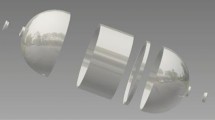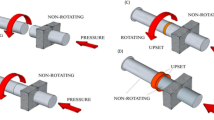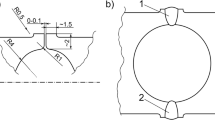Abstract
Friction stir welding (FSW) was used to join cast Ti–6Al–4V hemisphere and cylinder parts to produce a spacecraft propellant tank with reduced costs and lead time compared to conventional manufacturing. As a potential source for failure, the weld was inspected for residual stresses using three different methods: non-destructive neutron and X-ray diffraction as well as destructive hole drilling. The results showed lower residual stresses in the friction stir weld compared to results from conventional welding techniques such as electron beam welding or tungsten inert gas welding. In the hoop direction, a typical M-shaped residual stress profile centered around the weld was observed for both neutron and X-ray diffraction. According to the acquired data, the peak residual stresses (tensile) were measured in the heat-affected zone, up to a maximum of ~ 200 MPa. The results from the three different techniques generally compared well with each other, considering the rather significant differences between the methods.










Similar content being viewed by others
References
Thomas, W.M., Nicholas, E.D., Needham, J.C., Murch, M.G., Temple-Smith, P., Dawes, C.J.: Friction stir butt welding. International Patent Application No. PCT/GB92/02203; 1991. G.B. Patent Application No. 9125978.8 (1991)
Ghidini, T.: Fatigue life predictions of friction stir welded joints by using fracture mechanics methods. VDI-Verlag GmbH, Düsseldorf (2006)
Ghidini, T., Vugrin, T., Dalle Donne, C.: Residual stresses, defects and non-destructive evaluation of FSW joints. Weld. Int. (2005). https://doi.org/10.1533/wint.2005.3493
Pilchak, A.L., Juhas, M.C., Williams, J.C.: Microstructural changes due to friction stir processing of investment-cast Ti–6Al–4V. Metall. Mater. Trans. A. 38, 401–408 (2007). https://doi.org/10.1007/s11661-006-9061-x
Ma, Z.Y., Pilchak, A.L., Juhas, M.C., Williams, J.C.: Microstructural refinement and property enhancement of cast light alloys via friction stir processing. Scr. Mater. 58, 361–366 (2008). https://doi.org/10.1016/j.scriptamat.2007.09.062
Pilchak, A.L., Tang, W., Sahiner, H., Reynolds, A.P., Williams, J.C.: Microstructure evolution during friction stir welding of Mill-annealed Ti–6Al–4V. Metall. Mater. Trans. A. 42, 745–762 (2011). https://doi.org/10.1007/s11661-010-0439-4
Knipling, K.E., Fonda, R.W.: Microstructural evolution in Ti-5111 Friction Stir Welds. Metall. Mater. Trans. A. 42, 2312–2322 (2011). https://doi.org/10.1007/s11661-011-0630-2
Çam, G.: Friction stir welded structural materials: beyond Al-alloys. Int. Mater. Rev. 56, 1–48 (2011). https://doi.org/10.1179/095066010X12777205875750
Yoon, S., Ueji, R., Fujii, H.: Microstructure and texture distribution of Ti–6Al–4V alloy joints friction stir welded below beta-transus temperature. J. Mater. Process. Technol. 229, 390–397 (2015). https://doi.org/10.1016/j.jmatprotec.2015.09.041
Fall, A., Jahazi, M., Khdabandeh, A.R., Fesharaki, M.H.: Effect of process parameters on microstructure and mechanical properties of friction stir-welded Ti–6Al–4V joints. Int. J. Adv. Manuf. Technol. 91, 2919–2931 (2017). https://doi.org/10.1007/s00170-016-9527-y
Mironov, S., Sato, Y.S., Kokawa, H.: Friction-stir welding and processing of Ti–6Al–4V titanium alloy: a review. J. Mater. Sci. Technol. 34, 58 (2018). https://doi.org/10.1016/j.jmst.2017.10.018
John, R., Jata, K.V., Sadananda, K.: Residual stress effects on near-threshold fatigue crack growth in friction stir welds in aerospace alloys. Int. J. Fatigue. 25, 939–948 (2003). https://doi.org/10.1016/j.ijfatigue.2003.08.002
Zhang, Y., Sato, Y.S., Kokawa, H., Park, S.H.C., Hirano, S.: Microstructural characteristics and mechanical properties of Ti–6Al–4V friction stir welds. Mater. Sci. Eng. A. 485, 448–455 (2008). https://doi.org/10.1016/j.msea.2007.08.051
Liu, H.J., Zhou, L., Liu, Q.W.: Microstructural characteristics and mechanical properties of friction stir welded joints of Ti–6Al–4V titanium alloy. Mater. Des. 31, 1650–1655 (2010). https://doi.org/10.1016/j.matdes.2009.08.025
Wu, L.H., Wang, D., Xiao, B.L., Ma, Z.Y.: Microstructural evolution of the thermo-mechanically affected zone in a Ti–6Al–4V friction stir welded joint. Scr. Mater. 78–79, 17–20 (2014). https://doi.org/10.1016/j.scriptamat.2014.01.017
Sanders, D.G., Edwards, P., Cantrell, A.M., Gangwar, K., Ramulu, M.: Friction stir-welded titanium alloy Ti–6Al–4V: Microstructure, mechanical and fracture properties. Jom. 67, 1054–1063 (2015). https://doi.org/10.1007/s11837-015-1376-x
Bruno, G., Dunn, B.D.: Surface and bulk residual stress in Ti6Al4V welded aerospace tanks. J. Press. Vessel Technol. 126, 284–292 (2004). https://doi.org/10.1115/1.1763932
Pasta, S., Reynolds, A.P.: Residual stress effects on fatigue crack growth in a Ti–6Al–4V friction stir weld. Fatigue Fract. Eng. Mater. Struct. 31, 569–580 (2008). https://doi.org/10.1111/j.1460-2695.2008.01258.x
Edwards, P., Ramulu, M.: Surface residual stresses in Ti–6Al–4V friction stir welds: pre- and post-thermal stress relief. J. Mater. Eng. Perform. 24, 3263–3270 (2015). https://doi.org/10.1007/s11665-015-1610-2
ECSS-E-ST-32-01C: Space Engineering—Fracture Control. Eur. Coop. Sp. Stand. Rev. 1. https://ecss.nl/standard/ecss-e-st-32-01c-rev-2-fracture-control-30-july-2021/ (2009)
NASA-STD-5019: Fracture control requirements for spaceflight hardware. NASA. https://standards.nasa.gov/sites/default/files/nasa-std-5019a.pdf (2008)
Steuwer, A., Hattingh, D.G., James, M.N., Singh, U., Buslaps, T.: Residual stresses, microstructure and tensile properties in Ti–6Al–4V friction stir welds. Sci. Technol. Weld. Join. 17, 525–533 (2012). https://doi.org/10.1179/136217112X13439160184196
Withers, P.J., Bhadeshia, H.K.D.H.: Residual stress Part 2—Nature and origins. Mater. Sci. Technol. 17, 366–375 (2001). https://doi.org/10.1179/026708301101510087
Meisnar, M., Bennett, J.M., Andrews, D., Dodds, S., Freeman, R., Bellarosa, R., Adams, D., Norman, A.F., Rohr, T., Ghidini, T.: Microstructure characterization of a friction stir welded hemi-cylinder structure using Ti–6Al–4V castings. Mater. Charact. 147, 286–294 (2019). https://doi.org/10.1016/j.matchar.2018.11.019
Martin, J.P.: Stationary shoulder friction stir welding. In: Proc. 1st Int. Jt. Symp. Join. Weld., pp. 477–482. Woodhead Publishing (2013). https://doi.org/10.1533/978-1-78242-164-1.477
Jiang, X., Wynne, B.P., Martin, J.: Microstructure and texture evolution of stationary shoulder friction stir welded Ti6Al4V alloy. Sci. Technol. Weld. Join. 20, 594–600 (2015). https://doi.org/10.1179/1362171815Y.0000000043
Daymond, M., Edwards, L.: Scientific review: ENGIN-X: a fully refined diffractometer designed specifically for measurement of stress. Neutron News 15, 24–29 (2004). https://doi.org/10.1080/00323910490970573
Santisteban, J.R., Daymond, M.R., James, J.A., Edwards, L.: ENGIN-X: a third-generation neutron strain scanner. J. Appl. Crystallogr. 39, 812–825 (2006). https://doi.org/10.1107/S0021889806042245
Pawley, G.S.: Unit-cell refinement from powder diffraction scans. J. Appl. Crystallogr. 14, 357–361 (1981). https://doi.org/10.1107/S0021889881009618
Toby, B.H., Von Dreele, R.B.: {\it GSAS-II}: the genesis of a modern open-source all purpose crystallography software package. J. Appl. Crystallogr. 46, 544–549 (2013). https://doi.org/10.1107/S0021889813003531
Frankel, P., Preuss, M., Steuwer, A., Withers, P.J., Bray, S.: Comparison of residual stresses in Ti–6Al–4V and Ti–6Al–2Sn–4Zr–2Mo linear friction welds. Mater. Sci. Technol. 25, 640–650 (2009). https://doi.org/10.1179/174328408X332825
Romero, J., Attallah, M.M., Preuss, M., Karadge, M., Bray, S.E.: Effect of the forging pressure on the microstructure and residual stress development in Ti–6Al–4V linear friction welds. Acta Mater. 57, 5582–5592 (2009). https://doi.org/10.1016/j.actamat.2009.07.055
Daymond, M., Bonner, N.W.: Measurement of strain in a titanium linear friction weld by neutron diffraction. Phys. B Condens Matter (2003). https://doi.org/10.1016/S0921-4526(02)01514-4
Jun, T.-S., Hofmann, F., Hofmann, M., Korsunsky, A.M.: Residual stress characterization in 12%-Cr steel friction stir welds by neutron diffraction. J. Strain Anal. Eng. Des. 47, 203–213 (2012). https://doi.org/10.1177/0309324712441433
Withers, P.J., Preuss, M., Steuwer, A., Pang, J.W.L.: Methods for obtaining the strain-free lattice parameter when using diffraction to determine residual stress. J. Appl. Crystallogr. 40, 891–904 (2007). https://doi.org/10.1107/S0021889807030269
Altenkirch, J., Peel, M.J., Steuwer, A., Withers, P.J.: Comparison of methods to determine variations in unstrained unit cell parameter across welds. J. Strain Anal. Eng. Des. 46, 651–662 (2011). https://doi.org/10.1177/0959651811414643
Acknowledgements
The authors would like to acknowledge the funding source of this project, the ESA GSTP activity “Friction stir welded low-cost titanium propellant tank” and the UK Space Agency, as well as the project partners The Welding Institute (TWI) and Airbus UK. Many thanks also to UKRI, STFC ITAC, the ESA-RAL Advanced Manufacturing Laboratory, and the ESTEC laboratories for facilitating this work. Finally, the authors thank the ISIS neutron source, the Engin-X beamline, and its staff for their contributions.
Funding
European Space Agency GSTP program, UK Space Agency.
Author information
Authors and Affiliations
Contributions
Not applicable.
Corresponding author
Ethics declarations
Conflict of interest
There are no conflicts of interest known to the authors.
Availability of data and materials
The data are available in the repository of the European Space Agency.
Code availability
Not applicable.
Ethics approval
Not applicable.
Consent to participate
Not applicable.
Consent for publication
Not applicable.
Additional information
Publisher's Note
Springer Nature remains neutral with regard to jurisdictional claims in published maps and institutional affiliations.
Rights and permissions
About this article
Cite this article
Meisnar, M., Bennett, J.M., Andrews, D. et al. Advanced manufacturing of titanium propellant tanks for space applications part 2: a comparative study of residual stresses. CEAS Space J 15, 139–149 (2023). https://doi.org/10.1007/s12567-021-00398-w
Received:
Revised:
Accepted:
Published:
Issue Date:
DOI: https://doi.org/10.1007/s12567-021-00398-w




